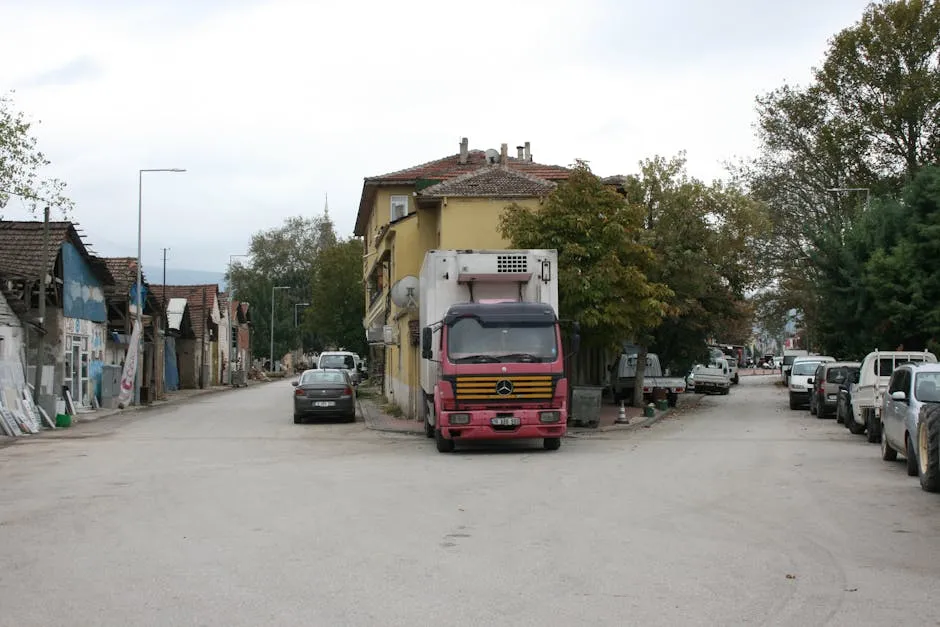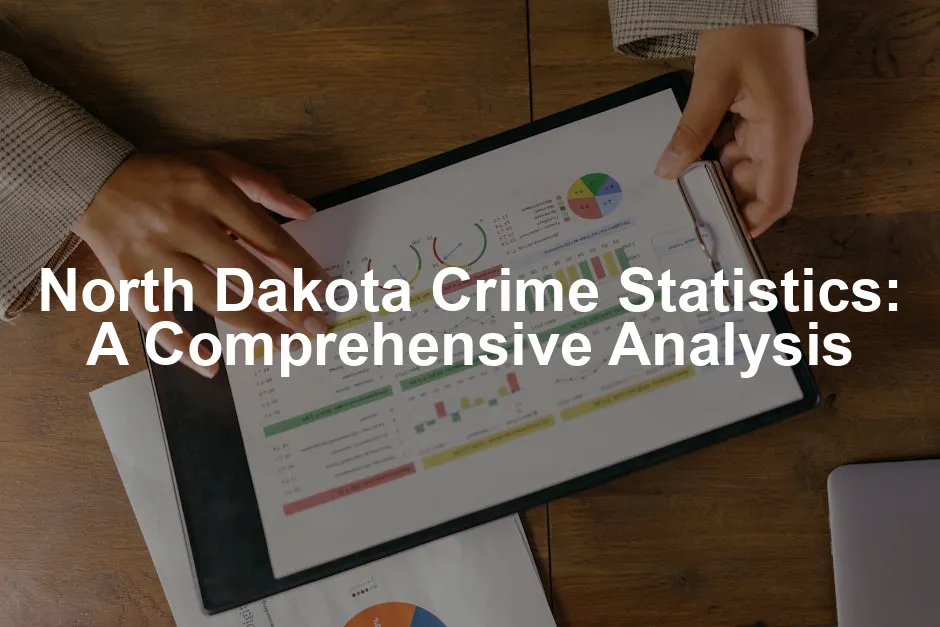Introduction
Crime statistics tell a story, and in North Dakota, it’s a tale worth telling. As residents, policymakers, and law enforcement keep a close eye on these figures, understanding crime trends becomes essential. Why? Because these statistics help shape our communities, influence policies, and affect our daily lives.
For residents, knowing the crime landscape means being informed. It allows you to make better choices about safety and community involvement. Meanwhile, policymakers can use this data to allocate resources effectively and create effective crime prevention strategies. Law enforcement agencies also rely on these statistics to plan their operations and prioritize their efforts.
If you want to dive deeper into crime statistics and trends, consider picking up Crime Statistics: A Guide to Understanding Crime Trends. This book will help you unpack the complex data and give you a clearer picture of the crime landscape.
This article aims to provide a detailed overview of North Dakota’s crime statistics. From trends over the years to comparisons with national averages, we’ll explore everything you need to know. So, buckle up as we dive into the numbers that shape our communities!

Overview of Crime in North Dakota
The crime landscape in North Dakota is unique, reflecting a blend of rural charm and urban challenges. As of the latest available data in 2023, the total number of reported crimes stands at a noteworthy 17,724. This figure encompasses a range of incidents, from minor offenses to serious crimes.
Breaking it down, we find that violent crimes account for 2,179 of these incidents, while property crimes dominate with a staggering 15,545 reported cases. This disparity highlights the state’s challenges regarding property safety, which warrants attention from both law enforcement and community members.
To better understand these statistics, we can look at crime rates per 1,000 residents. The overall crime rate in North Dakota is 22.74, with violent crimes at 2.80 and property crimes at a significant 19.95. These numbers not only provide a snapshot of the current situation but also serve as a valuable tool for comparison with other states.
Data sources such as the North Dakota Bureau of Criminal Investigation and the FBI’s Uniform Crime Reporting Program ensure that these statistics are accurate and reflect the reality of crime in the state. With this information at our fingertips, residents can feel empowered to engage in discussions about safety and community well-being.
In summary, North Dakota’s crime statistics reveal a complex landscape where understanding the nuances is critical. By examining the total number of crimes reported, the breakdown of violent and property crimes, and the sources of data, we can gain valuable insights into how crime affects our communities and what steps need to be taken to improve safety for all.
Speaking of safety, consider enhancing your home security with a Home Security Camera System. It’s a great way to keep an eye on your property and deter potential criminals.

Breakdown of Violent Crimes
Violent crimes are serious offenses that threaten the safety and well-being of individuals and communities. In North Dakota, violent crimes fall into four main categories: murder, rape, robbery, and aggravated assault. Understanding these categories is crucial to grasping the state’s crime landscape.
Murder
Murder is the most severe form of violent crime. It involves the unlawful killing of another person. In North Dakota, there were 27 reported cases of murder, resulting in a rate of 0.03 per 1,000 residents. While each murder is a tragedy, this figure indicates a relatively low occurrence compared to national averages. It’s important to analyze trends to understand whether this number is increasing or decreasing over time.
Rape
Next on the list is rape, a crime that devastates victims and communities alike. In North Dakota, there were 442 reported cases of rape, translating to a rate of 0.57 per 1,000 residents. This statistic highlights a significant issue that requires ongoing attention and resources for prevention and support for survivors. Historical data shows fluctuations in these numbers, and it’s vital to monitor trends to inform policy and community action.
For those interested in understanding the psychology behind these crimes, The Psychology of Crime: Understanding Criminal Behavior is a must-read. It dives into the motives and backgrounds of criminals, providing insights that can help in prevention.
Robbery
Robbery, which involves taking property from a person through force or threat, is another serious concern. North Dakota recorded 215 cases of robbery, with a rate of 0.28 per 1,000 residents. This statistic indicates a relatively low incidence of robbery, yet it still reflects a need for vigilance in personal safety and awareness of surroundings.
Aggravated Assault
The most frequently reported violent crime in North Dakota is aggravated assault. With 1,495 cases reported, the rate stands at 1.92 per 1,000 residents. This figure accounts for a significant portion of the violent crime landscape in the state. Aggravated assault often stems from domestic disputes or altercations, making community education and intervention paramount to prevention.
Trends Over the Years
When analyzing violent crime trends in North Dakota, it’s essential to consider the historical context. Over the past few years, reports suggest a slight increase in certain violent crimes, particularly aggravated assault. The 2023 crime statistics indicate a 2.9% rise in violent crimes overall, which aligns with trends observed nationally.
Interestingly, while murder rates remain low, the increase in aggravated assault calls for heightened awareness and effective community programs aimed at conflict resolution and support systems. Continuous monitoring of these trends will be crucial for law enforcement and policymakers to adapt their strategies effectively.
In summary, North Dakota’s violent crime statistics reveal a mixed picture. While murder and robbery rates remain relatively low, the prevalence of aggravated assault reflects a pressing issue. Addressing these challenges requires community engagement and proactive measures to ensure safety. Understanding the nuances of violent crime trends is vital for fostering informed discussions around public safety and crime prevention initiatives.

Crime Trends Over the Years
Analyzing crime data from 2010 to today reveals intriguing trends in North Dakota’s property crime rates. The state has seen notable shifts, particularly in burglary, theft, and motor vehicle theft. Understanding these trends is essential for residents and businesses alike.
From 2010 to 2019, property crime rates fluctuated. In 2010, North Dakota reported approximately 15,000 property crimes. By 2015, that number increased to around 16,500. This uptick sparked concerns among residents. However, a turnaround occurred in 2019 when reported property crimes dipped to about 15,000 once more. This decrease suggested a positive trend, leading many to breathe a sigh of relief.
What factors contribute to these changes? Economic shifts play a significant role. For instance, the oil boom in the Bakken region brought an influx of workers and cash flow, but it also led to increased crime rates. As communities adapted, law enforcement and local organizations implemented strategies to combat rising crime. This response helped stabilize property crime rates.
In 2020, the global pandemic introduced unique challenges. The lockdowns disrupted daily routines and altered crime patterns. Surprisingly, property crimes like burglary saw a decrease, likely due to more people staying home. While thefts did rise in some areas, overall property crime remained lower than in previous years.
By 2023, the trend continued to stabilize. The total number of property crimes reported was 15,545, showing a slight increase from 2022. This rise could be attributed to the economic recovery and population growth as communities bounced back from pandemic impacts.
Year by year, specific statistics stand out. For example, in 2016, North Dakota experienced a high in vehicle thefts, with over 2,500 incidents reported. This prompted law enforcement to launch targeted initiatives to raise awareness and prevent these crimes. By 2021, the focus on prevention paid off as vehicle thefts dropped significantly.
It’s essential to highlight that while property crime rates have shown fluctuations, North Dakota has generally maintained lower rates than national averages. The national rate for property crime stands at around 20 per 1,000 residents, while North Dakota’s current rate is approximately 19.95 per 1,000 residents. This comparison illustrates the state’s relatively safe living environment, despite the occasional spikes in crime.
External factors, including community engagement and law enforcement strategies, have undoubtedly influenced these trends. Law enforcement agencies have ramped up outreach efforts, establishing programs to educate residents on crime prevention. Neighborhood watch groups have also gained traction, enabling communities to work together to enhance safety.
In conclusion, the property crime landscape in North Dakota is characterized by ups and downs, shaped by economic changes, population shifts, and community engagement. By keeping a watchful eye on these trends, residents and businesses can better prepare and respond to the challenges that may arise, fostering a safer environment for all.

Don’t forget to equip yourself with a Personal Safety Alarm. It’s a handy gadget that can provide peace of mind and help in emergencies.
Law Enforcement and Crime Prevention Efforts
Law enforcement agencies play a pivotal role in reporting and preventing crime in North Dakota. These agencies, from local police departments to the state Bureau of Criminal Investigation, ensure that crime data is accurately collected and analyzed. This process is crucial for understanding crime trends and developing effective strategies for prevention.
In recent years, North Dakota law enforcement has embraced innovative approaches to tackle crime. For example, in 2023, the Fargo Police Department launched a new community policing initiative. This program encourages officers to build relationships with residents while addressing public safety concerns. By fostering trust, officers can gain insights into local issues and improve community engagement.
Moreover, the state has seen a shift towards data-driven policing strategies. Agencies analyze crime statistics to identify hotspots and allocate resources effectively. This proactive stance enables law enforcement to respond swiftly to potential threats, ultimately enhancing community safety.
Community programs also play a vital role in reducing crime. Numerous initiatives focus on youth engagement and crime prevention. For instance, the North Dakota Crime Prevention Association supports programs that educate children about safety. These efforts aim to equip young people with the knowledge necessary to avoid risky situations.
Additionally, neighborhood watch programs empower residents to take charge of their safety. By working together, community members can monitor suspicious activities and report them to local authorities. This collaborative approach not only deters potential criminals but also fosters a sense of unity among neighbors.
Another significant initiative is the collaboration between law enforcement and social services. Addressing root causes of crime, such as substance abuse and mental health issues, is essential. By providing support services, law enforcement can help individuals reintegrate into society, reducing the likelihood of reoffending.
In summary, law enforcement agencies in North Dakota are actively engaged in crime reporting and prevention. Through innovative strategies and community programs, they work to create safer environments for residents. As these efforts continue to evolve, the state’s approach to crime prevention will adapt to meet the challenges of the future.

To further enhance your safety, consider investing in a Pepper Spray. It’s an effective self-defense tool that can help you feel more secure when you’re out and about.
Conclusion
In reviewing North Dakota’s crime statistics, several key findings emerge. The state has experienced fluctuations in crime rates, with an overall increase in certain violent crimes. However, property crime rates have shown signs of stabilization. Understanding these trends is crucial for residents and policymakers alike.
Ongoing monitoring of crime statistics is essential for maintaining community safety. As crime patterns change, law enforcement must adapt their strategies accordingly. This flexibility is vital to ensure that resources are allocated effectively and that communities remain informed.
Residents are encouraged to engage with local law enforcement efforts actively. By participating in community programs and staying informed, individuals can contribute to a safer environment. Whether through neighborhood watch programs or attending local safety meetings, community engagement is key.
Moreover, staying connected with law enforcement updates is vital for understanding crime trends. With accurate information, residents can make informed decisions about their safety and well-being. Engaging with local agencies fosters trust and collaboration, ultimately leading to stronger communities.
In conclusion, North Dakota’s crime statistics highlight the importance of vigilance and community involvement. By prioritizing safety and supporting law enforcement initiatives, residents can help create an environment where everyone feels secure. Continue to stay informed and engaged, and together, we can work towards a safer North Dakota.
And while you’re at it, why not consider a Emergency First Aid Kit? It’s always better to be prepared for any situation!

FAQs
What are the current crime rates in North Dakota?
Recent statistics reveal that North Dakota recorded a total of 17,724 crimes in 2023. This total includes 2,179 violent crimes and 15,545 property crimes. The overall crime rate stands at 22.74 per 1,000 residents, with a violent crime rate of 2.80 and a property crime rate of 19.95.
How does North Dakota’s crime rate compare to other states?
North Dakota’s crime rate is relatively low compared to national averages. The violent crime rate in the state is 2.80 per 1,000 residents, while the national median is approximately 4 per 1,000. Similarly, the property crime rate in North Dakota is 19.95 per 1,000 residents, compared to the national median of around 20 per 1,000. This comparison illustrates that North Dakota is generally safer than many other states.
What are the safest cities in North Dakota?
Some of the safest cities in North Dakota include Fort Ransom, Flasher, and Fullerton, based on the latest data. These cities boast low crime rates and strong community engagement, making them ideal places to live.
What should residents do to protect themselves from crime?
Residents should stay vigilant and informed about their surroundings. Joining local neighborhood watch programs, participating in community safety meetings, and utilizing crime prevention resources can significantly enhance personal safety.
Where can I find more detailed crime statistics for North Dakota?
Official resources such as the North Dakota Bureau of Criminal Investigation and the FBI’s Uniform Crime Reporting Program provide access to detailed crime statistics. These platforms offer comprehensive insights into crime trends and data for public review.
For more detailed insights into the crime landscape in North Dakota, you can explore the North Dakota Crime Statistics.
Please let us know what you think about our content by leaving a comment down below!
Thank you for reading till here 🙂
All images from Pexels




